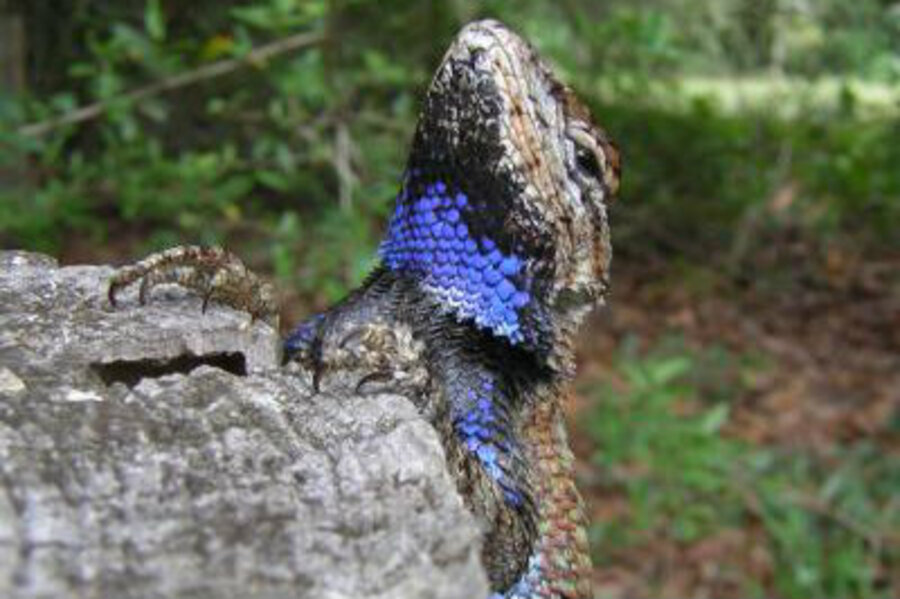Female lizards with beards not attractive, report other lizards
Loading...
Somewhere, a spurned female fence lizard is feeling blue about her beard.
Ecologists at Penn State University reported this week that male fence lizards discriminate against female fence lizards sporting blue “beards” – dabbles of bright azure scales on their necks and along their sides – preferring instead to lavish their attention on beardless females. That’s a find that scientists say may suggest that natural selection will in time trim out female lizards with too much of a beard.
“This was really striking since female ornamentation in this species is thought to serve no function and has been ignored by scientists,” says Tracy Langkilde, a biologist at Penn State University and the principal investigator on the paper, published in the journal Biology Letters, in an email interview. “It’s clear that it in fact plays a role in male mate choice, and has some potentially important consequences for reproductive success.”
Eastern fence lizards, so called for their proclivity for sitting on fence posts, are found throughout the southeastern corridors of the United States. From an aerial view, the small lizard, about six inches long, is uninspiring to look at: knobby and brown-grey, it could be missed against a tree truck’s bark.
Viewed from the side or below, though, the lizard paints a different picture. Male fence lizards have bright blue patches on their throats and along their sides that become ever more visible when the lizard wishes to court a female lizard. Previous studies have suggested that the blue beards are a product of heightened testosterone, as the would-be lover musters up all the gall it can get to attract its chosen partner.
But it’s not just male lizards that have this sapphire coloring. Some females, but not all of them, have it too.
Now, which females do males prefer as mating partners? The females with the splendid blue cascade skimming down their throats and rimming their sides? Or the plain ones?
The plain ones, it turns out.
In 2008, the researchers collected 24 pregnant females and raised their offspring (female fence lizards give birth three times per year, to a number of eggs that depends on the size of each one’s egg cavity, which can range from three to 16 eggs). In 2009, the team then conducted an experiment in which two randomly selected females were tethered in an arena while a male was released into the space; the scientists measured how long the male spent fraternizing with each of the luckless, tethered females, as well as whether or not the female had a beard.
Though the males did not entirely snub the bearded females, they displayed a clear preference for the females without the blue markings, the researchers said.
There are some good reasons for this. In further research, the team found that blue-bedazzled female lizards appear to lay their eggs 13 days later than do plain female lizards, like a jewel-dripping socialite who can’t be bothered with the pressing task at hand. This lateness puts their hatchlings (fence lizard babies are independent at birth) at a competitive disadvantage against the early-hatchers. The bearded lizard’s eggs were also lighter than the plain lizard’s eggs, suggesting a lower nutritional content in the yolks.
Up to this point, it makes Darwinian sense that male lizards would prefer the female lizards most likely to give their offspring a fighting chance. But there’s a problem – some 44 to 95 percent of females have a blue beard. So, if male lizards are biased against adorned lizards, then why do blue-tinged females often outnumber plain females in their ecosystems?
The finding “suggests that these bearded ladies should produce fewer offspring than unornamented females and, assuming this trait is passed down from one generation to the next, the proportion of bearded ladies in a population should be declining,” says Dr. Langkilde. “This is one of the puzzles presented by these results.”
One option is that lizards are somewhere in the middle of a gradual weeding out of the blue-bearded female lizards, says Lindsey Swierk, a graduate student at Penn State and a co-author the paper, in an email interview.
“It’s possible that we’re catching a snapshot of the evolutionary process,” says Ms. Swierk.
That would mean that, at some point, “bearded” female lizards had once been desirable to male suitors, but that some social or environmental factors had adjusted to put the blue-throated girls on the outs, she says.
But it’s also possible that the blue-bearded ladies are not going anywhere soon. The researchers propose that these female lizards might have other advantages that keep their numbers up, despite the male disapproval.
One option is that these females, pumped up with testosterone, might be more aggressive about mating than are their un-bearded counterparts. Another option is that these lizards might have “especially sexy sons,” as Langklide puts it, that go on to entice females with their exceptional blue beards and reproduce in droves. These successful sons’ offspring, it would seem, would include lots and lots of blue-bearded daughters.








